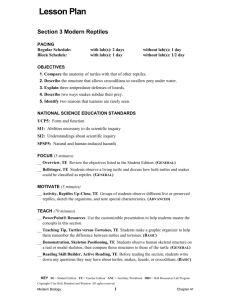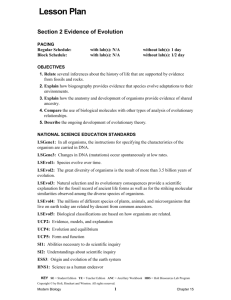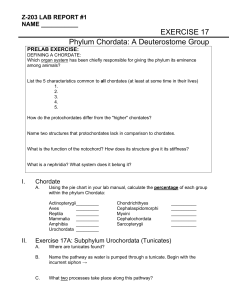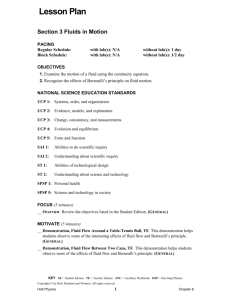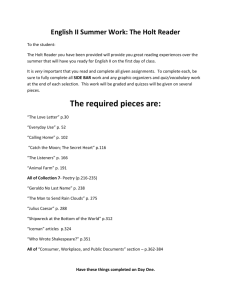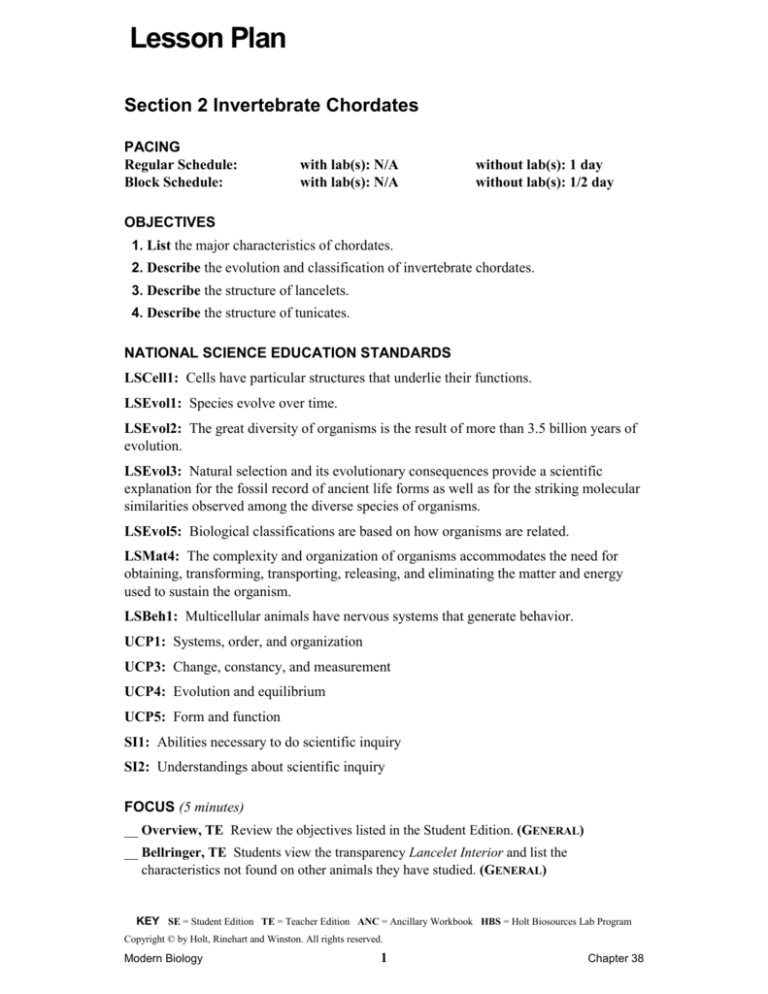
Lesson Plan
Section 2 Invertebrate Chordates
PACING
Regular Schedule:
Block Schedule:
with lab(s): N/A
with lab(s): N/A
without lab(s): 1 day
without lab(s): 1/2 day
OBJECTIVES
1. List the major characteristics of chordates.
2. Describe the evolution and classification of invertebrate chordates.
3. Describe the structure of lancelets.
4. Describe the structure of tunicates.
NATIONAL SCIENCE EDUCATION STANDARDS
LSCell1: Cells have particular structures that underlie their functions.
LSEvol1: Species evolve over time.
LSEvol2: The great diversity of organisms is the result of more than 3.5 billion years of
evolution.
LSEvol3: Natural selection and its evolutionary consequences provide a scientific
explanation for the fossil record of ancient life forms as well as for the striking molecular
similarities observed among the diverse species of organisms.
LSEvol5: Biological classifications are based on how organisms are related.
LSMat4: The complexity and organization of organisms accommodates the need for
obtaining, transforming, transporting, releasing, and eliminating the matter and energy
used to sustain the organism.
LSBeh1: Multicellular animals have nervous systems that generate behavior.
UCP1: Systems, order, and organization
UCP3: Change, constancy, and measurement
UCP4: Evolution and equilibrium
UCP5: Form and function
SI1: Abilities necessary to do scientific inquiry
SI2: Understandings about scientific inquiry
FOCUS (5 minutes)
__ Overview, TE Review the objectives listed in the Student Edition. (GENERAL)
__ Bellringer, TE Students view the transparency Lancelet Interior and list the
characteristics not found on other animals they have studied. (GENERAL)
KEY SE = Student Edition TE = Teacher Edition ANC = Ancillary Workbook HBS = Holt Biosources Lab Program
Copyright © by Holt, Rinehart and Winston. All rights reserved.
Modern Biology
1
Chapter 38
Lesson Plan
MOTIVATE (5 minutes)
__ Demonstration, Lancelet Differences, TE Students examine the lancelets in the figure
and discuss how a lancelet is similar to a fish and how it is different. (BASIC)
__ Internet Activity, Chordates, TE Have students research chordates by using the Internet
Connect box on this page. (ADVANCED)
TEACH (25 minutes)
__ PowerPoint® Resources Use the customizable presentation to help students master the
concepts in this section.
__ Quick Lab, Modeling Chordate Characteristics, SE Students use clay to build models
of a lancelet and an adult tunicate. (BASIC)
__ Datasheets for In-Text Labs, Modeling Chordate Characteristics, ANC Students use
the datasheet to complete the Quick Lab. (GENERAL)
__ Reading Skill Builder, K-W-L, TE Students read over the lists they made in the first
section and list what they have learned and which questions remain unanswered. (BASIC)
__ Activity, Tunicate Features, TE Students examine live tunicates and try to find
structures mentioned in the text,. (GENERAL)
__ Teaching Transparency H45, Lancelet Interior Use this transparency to explore the
lancelet’s interior. (GENERAL)
__ Teaching Transparency H46, Exploration of a Lancelet Use this transparency to
review the characteristics of a lancelet. (GENERAL)
__ Teaching Transparency H47, Adult Tunicate Use this transparency to explore the
features of the adult tunicate. (GENERAL)
CLOSE (10 minutes)
__ Section Review, SE Students are assessed through questions about key concepts and
questions that require critical thinking skills. (GENERAL)
__ Reteaching, Comparing Lancelets and Tunicates, TE Students make tables comparing
lancelets and tunicates. (BASIC)
__ Quiz, TE Students answer short answer questions about this section. (GENERAL)
OTHER RESOURCE OPTIONS
__ Visual Concepts CD-ROM Use this multimedia resource to reinforce selected concepts
from the chapter.
__ Active Reading Worksheets, ANC Students are asked to analyze a passage related to the
chapter text and answer questions about the passage. (BASIC)
__ Quick, Data, and Math Labs, Comparing the Structure of the Notochord and Nerve
Cord, HBS Students view a cross section of an adult lancelet to compare the notochord
and nerve cord. (GENERAL)
KEY SE = Student Edition TE = Teacher Edition ANC = Ancillary Workbook HBS = Holt Biosources Lab Program
Copyright © by Holt, Rinehart and Winston. All rights reserved.
Modern Biology
2
Chapter 38
Lesson Plan
__ Skills Practice Labs, Comparing Echinoderms and Invertebrate Chordates, HBS
Students examine and compare preserved specimens from the phylum Echinodermata and
the subphylums Urochordata (tunicate) and Cephalochordata (lancelet). (GENERAL)
KEY SE = Student Edition TE = Teacher Edition ANC = Ancillary Workbook HBS = Holt Biosources Lab Program
Copyright © by Holt, Rinehart and Winston. All rights reserved.
Modern Biology
3
Chapter 38
Lesson Plan
End of Chapter Review and Assessment
PACING
Regular Schedule:
Block Schedule:
with lab(s): N/A
with lab(s): N/A
without lab(s): 2 days
without lab(s): 1 days
__ Alternative Assessment, K-W-L, TE Students read over the lists they have made for
each section and discover what questions still remain unanswered. (GENERAL)
__ Study Tip, Study Tip, TE Students label the parts of echinoderms, lancelets, and
tunicates they have studied. (GENERAL)
__ PowerPoint® Resources Use the customizable presentation to help students practice
standardized test-taking skills.
__ Chapter Highlights, SE Students review the key concepts of the chapter.
__ Chapter Review, SE Students are assessed through vocabulary exercises, questions
about key concepts, and questions that require critical thinking skills.
__ Standardized Test Preparation, SE Assign these questions with a time limit to prepare
students for standardized testing. (GENERAL)
__ Science Skills Worksheet, ANC This worksheet helps reinforce students’ use of basic
science skills. (GENERAL)
__ Study Guide, ANC Use this worksheet to assess student’s understanding of the main
concepts presented in the chapter. (GENERAL)
__ Graphic Organizer Transparency, Use this graphic organizer exercise to help students
analyze the relationships between concepts presented in the chapter. (GENERAL)
__ Concept Mapping Transparency, Use this concept mapping exercise to help students
analyze the relationships between concepts presented in the chapter. (GENERAL)
__ Concept Mapping Transparency Worksheet, Assign the concept mapping transparency
worksheet for students to map the relationships between concepts presented in the chapter.
(GENERAL)
__ Vocabulary Review, ANC Use this worksheet to reinforce vocabulary terms presented in
the chapter. (GENERAL)
__ Critical Thinking Worksheet, ANC This worksheet exercises students’ critical thinking
skills while applying concepts presented in the chapter. (ADVANCED)
__ Quiz, ANC Assign the one-page chapter quiz for a quick chapter assessment. (GENERAL)
__ Chapter Test A, ANC Assign questions from the appropriate test for chapter assessment.
(GENERAL)
__ Chapter Test B, ANC Assign questions from the appropriate test for chapter assessment.
(ADVANCED)
__ Test Generator, Create a customized homework assignment, quiz, or test using the
ExamView® Test Generator.
KEY SE = Student Edition TE = Teacher Edition ANC = Ancillary Workbook HBS = Holt Biosources Lab Program
Copyright © by Holt, Rinehart and Winston. All rights reserved.
Modern Biology
4
Chapter 38
Lesson Plan
__ Test Item Listing, Use the Test Item Listing to identify questions for a customized
homework assignment, quiz, or test.
__ Holt PuzzlePro® Use this software to create crossword puzzles and word searches that
make learning vocabulary fun.
__ Biology Interactive Tutor CD-ROM, Use these interactive activities to give students a
fun way to extend their knowledge of biology concepts.
OTHER RESOURCE OPTIONS
__ Brain Food Video Quizzes, Use these quizzes to help students review the chapter
material.
KEY SE = Student Edition TE = Teacher Edition ANC = Ancillary Workbook HBS = Holt Biosources Lab Program
Copyright © by Holt, Rinehart and Winston. All rights reserved.
Modern Biology
5
Chapter 38

